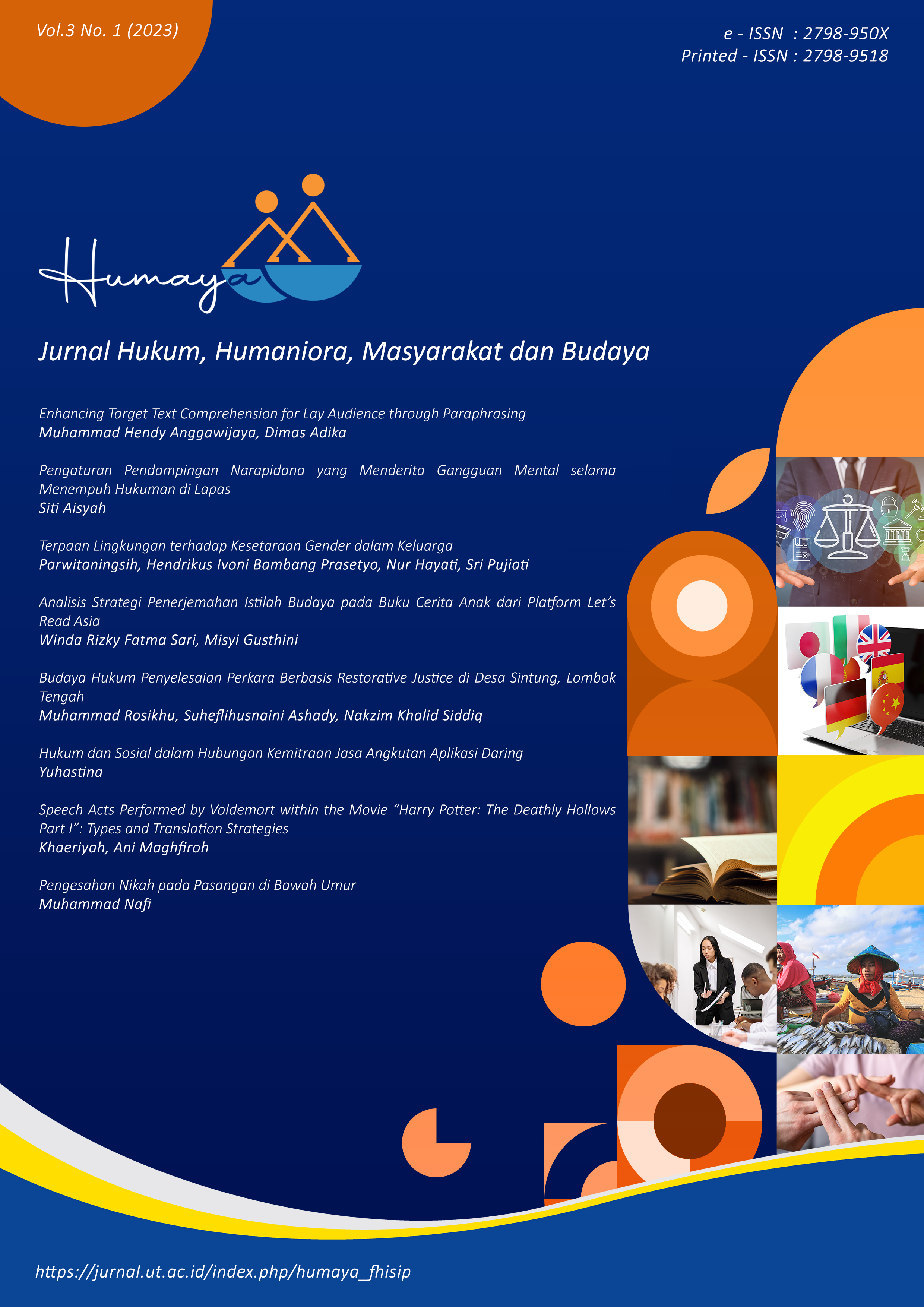Budaya Hukum Penyelesaian Perkara Berbasis Restorative Justice di Desa Sintung, Lombok Tengah
DOI:
https://doi.org/10.33830/humaya.v3i1.3809Keywords:
Legal Culture, Case Resolution, Restorative JusticeAbstract
In an effort to resolve cases, when the victims are women as part of a marginal group, inequality often occurs. Men who hold authority to resolve cases often take sides and incriminate their victims so that the values of legal certainty, justice and expediency are difficult to achieve even though there is peace as a result of the settlement of the case. Besides women, small communities or marginalized groups, people with disabilities are also included in marginal groups. Access to certainty, justice and the benefit of the law is a necessity that this marginal group must obtain. The law must not be dominated by certain groups who are close to certain power, capital, or social status. This problem occurs because part of the inheritance has not been handed over to the rightful party, for this problem then the Village Sangkep Hall carries out a restorative justice process. Finally, an agreement is reached in which one the aggrieved party gets his share and the party who controls the object of the dispute submits it knowingly and voluntarily. The problem ended with each party making a statement that contained a willingness to end the case and not sue each other in the future. Restorative justice has not been comprehensively regulated in various laws and regulations in Indonesia, the term restorative justice is only regulated in the Act. Number 11 of 2012 concerning the Juvenile Criminal Justice System. Sintung Village, in the process of resolving cases, has fulfilled the main principles of restorative justice. This process has succeeded in maintaining order and security in the Sintung Village environment, in addition, the community also supports the existence of the Village Sangkep Hall.
References
Aries, A. (2006). Penyelesaian Perkara Pencurian Ringan dan Keadilan Restoratif. In Majalah Varia Peradilan, Tahun XX No. 247. Penerbit Ikatan Hakim Indonesia.
Ashady, S. (2017). Pendekatan Restorative Justice dalam Penyelesaian Perkara Kekerasan dalam Rumah Tangga (Studi Kasus Kekerasan Fisik terhadap Istri dalam Perkara Kekerasan dalam Rumah Tangga di Lombok Timur, NTB. Universitas Gadjah Mada.
Friedman, L. M. (2018). Sistem Hukum: Perspektif Ilmu Sosial. Nusa Media.
Johnstone, G., & Ness, D. W. (2007). The Meaning of Restorative Justice. Handbook of Restorative Justice, 5–23.
Liebmann, M. (2007). Restorative Justice: How It Works. In Restorative justice: How it works. Jessica Kingsley Publishers.
Muchti, F., & Achmad, Y. (2010). Dualisme Penelitian Hukum: Normatif dan Empiris. Pustaka Pelajar.
Muhammad, A. (2004). Hukum dan Penelitian Hukum. PT. Citra Aditya Bakti.
Nasri, U. (2018). Perempuan Sasak “Memotret Bias Gender dalam Konteks Sosio-Kultural Lombok menuju sebuah Humanisme Sosial-Spiritual.” Al-Munawwarah: Jurnal Pendidikan Islam, 10(2).
Notonagoro. (1957). Berita Pikiran Ilmiah tentang Kemungkinan Djalan Keluar dari Kesulitan mengenai Pantjasila sebagai Dasar Negera Republik Indonesia. Universitas Gadjah Mada.
Peraturan Kejaksaan Republik Indonesia Nomor 15 Tahun 2020 tentang Penghentian Penuntutan Berdasarkan Keadilan Restoratif, (2020). https://jdihn.go.id/files/760/berkas_4150.pdf
Rokhmansyah, A. (2016). Pengantar Gender dan Feminisme: Pemahaman Awal Kritik Sastra Feminisme. Garudhawaca.
Sahbani, A. (2021). Kejaksaan Hentikan 222 Perkara Lewat Keadilan Restoratif. Hukum Online. https://www.hukumonline.com/berita/a/kejaksaan-hentikan-222-perkara-lewat-keadilan-restoratif-lt601056e7ece43/
Sitorus, A. D. P. (2019). Ultimum Remedium dan Primum Remedium dalam Sistem Hukum Pidana Indonesia. Indonesiare. https://indonesiare.co.id/id/article/ultimum-remedium-dan-primum-remedium-dalam-sistem-hukum-pidana-indonesia
Surat Edaran Kepala Kepolisian Negara Republik Indonesia Nomor 2/11/2021 tentang Kesadaran Budaya Beretika untuk Mewujudkan Ruang Digital Indonesia yang Bersih, Sehat, dan Produktif, (2021).
Surat Edaran Kepala Kepolisian Republik Indonesia No. 8/VII/2018 tentang Penerapan Keadilan Restoratif (Restorative Justice) dalam Penyelesaian Perkara Pidana, (2018). https://erepository.uwks.ac.id/7435/7/LAMPIRAN.pdf
Undang-Undang Dasar Negara Republik Indonesia Tahun 1945, (1945). https://www.mkri.id/public/content/infoumum/regulation/pdf/UUD45%20ASLI.pdf
Undang-Undang Republik Indonesia Nomor 11 Tahun 2012 tentang Sistem Peradilan Pidana Anak, (2012). https://www.balitbangham.go.id/po-content/peraturan/uu%20no.%2011%20tahun%202012%20tentang%20sistem%20peradilan%20pidana%20anak.pdf
Undang-Undang Republik Indonesia Nomor 30 Tahun 1999 tentang Arbitrase dan Alternatif Penyelesaian Sengketa, (1999). https://www.dpr.go.id/dokjdih/document/uu/UU_1999_30.pdf
United Nations. (2020). Handbook on Restorative Justice Programmes (2nd ed.). United Nations Office.
Wahid, E. (2009). Keadilan Restoratif dan Peradilan Konvensional dalam Hukum Pidana. Universitas Trisakti.
Wulandari, E. (2021). Problematika Bale Sangkep Desa dalam Memutuskan Konflik Rumah Tangga di Desa Sintung Kecamatan Pringgarata Kabupaten Lombok Tengah [Unpublished Thesis]. Universitas Islam Negeri Mataram.
Zakaria, R. Y. (2018). Etnografi Tanah Adat: Konsep-Konsep Dasar dan Pedoman Kajian Lapangan. Agrarian Resources Center.
Zulfa, E. A. (2009). Keadilan Restoratif. Badan Penerbit Fakultas Hukum Universitas Indonesia.
Downloads
Published
How to Cite
Issue
Section
License
Copyright (c) 2023 Muhammad Rosikhu, Suheflihusnaini Ashady, Nakzim Khalid Siddiq

This work is licensed under a Creative Commons Attribution-ShareAlike 4.0 International License.




